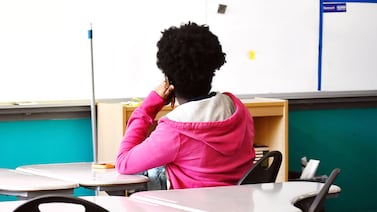Sign up for Chalkbeat Indiana’s free daily newsletter to keep up with Indianapolis Public Schools, Marion County’s township districts, and statewide education news.
The 2024 ILEARN scores released Wednesday showed slight changes from last year’s scores.
Statewide test scores for all Indiana students in grades 3 to 8 show less than a half of a percentage point change in students proficient or better in English language arts, math, and the subjects combined.
Scores went up slightly for the subjects combined and for English, but down slightly for math.
In 2024, 30.8% of students in third through eighth across the state were proficient or better in both the English and math sections of the state assessment. That’s 0.2 percentage points more than 30.6% in 2023.
By subject, 41% of students were proficient or better in English language arts, and 40.7% were proficient or better in math. That’s a small increase — less than half a percentage point — in English from 40.7% in 2023 and a small decrease in math from 40.9% last year.
Despite the slight change from 2023, scores are up since 2021, which the state considers to be the baseline year for the test due to the COVID-19 pandemic. The 2024 scores are up 0.5 and 3.8 percentage points in English and math respectively compared to 2021. For the combined proficiency, this year’s rate is up 2.2 percentage points from 28.6% in 2021.
However, results remain below pre-pandemic levels. In 2019, the first year of the ILEARN assessment, around 37% of students scored proficient or better in both English and math and roughly 48% of students scored proficient in at least one of the sections.
“We have work to do,” Indiana Secretary of Education Katie Jenner said, referring to improving the ILEARN assessment so teachers and families can help struggling students earlier. “We know that. We’re going to continue to roll up our sleeves as educators.”
She noted that in the 2024-25 school year, the Indiana Department of Education is piloting a checkpoint-based ILEARN — an alternative to a single high-stakes exam at the end of the year — to make the data more actionable. More than 70% of schools opted into the pilot program to have ILEARN be three checkpoints throughout the year and a shortened summative assessment at the end of the year, per the Indiana Department of Education.
This approach aims to have more data about student learning available throughout the school year for students, families, and teachers to use instead of waiting for the data at the end of the year, per IDOE. The change will be fully rolled out in the 2025-26 school year.
This year’s results also come amid an ongoing shift in how Indiana teaches reading.
Per a 2023 law, schools must adopt a literacy curriculum aligned to the science of reading by the 2024-25 school year. Many have already adopted these standards, as well as hired literacy coaches whose job is to train existing staff in reading science principles. But more changes are to come, including a requirement that teachers who hold an elementary license earn a new literacy endorsement.
At Indianapolis Public Schools, proficiency rates dropped from 2023 with English proficiency down 1.5 percentage points and math down 1.8 percentage points. Overall, 13.5% of students were proficient in both subjects, a drop from 14.8% in 2023.
Meanwhile, Brownsburg schools in neighboring Hendricks County had the highest percentage of students who tested proficient again this year at 62.6%.
See how students at your school did on the ILEARN test using the table below:
Black students show greatest ELA gains; other student groups’ test scores change very slightly
By demographics, certain groups saw slight score increases, often within or just over a percentage point.
At the State Board of Education meeting on Wednesday, board member Scott Bess commended the modest improvements but said the board can’t be satisfied with one- and two-point increases.
“Kudos to everyone who’s working hard to get those increases,” Bess said. “But it’s not enough. We’ve got to really have a sense of urgency.”
Black students’ proficiency in English language arts and math combined went up from 10.9% in 2023 to 11.7%. Those students also gained in English language arts by 1.2 percentage points, the largest increase by student race.
Both Hispanic students’ and Asian students’ scores changed marginally, the former decreasing by 0.1 and the latter increasing by 0.2 percentage points. English language learners’ proficiency increased by 0.3 percentage points.
The overall proficiency of students who qualify for free or reduced lunch improved from 17.6% to 18.1%.
Looking at grade level, seventh graders had the highest year-to-year increase in English language arts with 2.3 percentage points. Fourth graders also had a bump at 1.5 percentage points. Since 2021, English proficiency has increased for grades four to seven.
Although most grades showed less proficiency from 2023 to 2024 in math, math proficiency has increased across all grades since 2021. Seventh graders saw an increase by 1 percentage point from 2023 to 2024.
SAT scores continue to decline
The Indiana Department of Education also released SAT results Wednesday. The number of high school juniors at the benchmark for reading/writing and math was about 24%, a decrease of 4.4 percentage points compared to last year, continuing a two-year downward trend.
IDOE Chief Academic Officer Lynn Schemel said scores also decreased nationally, which she attributed to the challenges of hybrid learning faced by this cohort during the pandemic and the SAT’s switch to an adaptive assessment, meaning questions become more or less difficult depending on how the student is performing.
She added that chronic absenteeism also leads students to dramatically underperform on the exam, based on data from the last two years.
“In the year prior, as a grade 11 student, those students who were chronically absent underperformed their peers by 24.7 and 23.6 percentage points, demonstrating a need to focus on student apathy as we consider our high school redesign efforts,” Schemel said.
Aleksandra Appleton and MJ Slaby contributed to this article.
Haley Miller is a summer reporting intern covering education in the Indianapolis area. Contact Haley at hmiller@chalkbeat.org.







